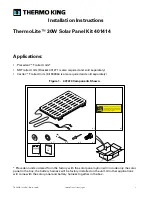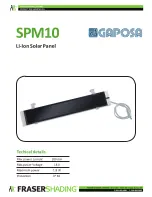
| 4
EN-Rev IM/GN-AM-EN/2.71 Copyright © June, 2021. CSI Solar Co., Ltd.
www.csisolar.com
Prior to installation, remove all metallic
jewelry to prevent accidental exposure to
live circuits.
When installing modules in light rain,
morning dew, take appropriate measures
to prevent water ingress into the
connector.
Do not
allow children or unauthorized
persons near the installation site or
module storage area.
Do not
install modules in strong wind.
Use electrically insulated tools to reduce the risk of
electric shock.
If the disconnects and over current protection devices
(OCPDs) cannot be opened or the inverter cannot be
powered down, cover the fronts of the modules in the
PV array with an opaque material to stop the
production of electricity when installing or working on
a module or wiring.
Carry the panels using both hands and do not use the
junction box or cables as a grip
Do not allow the panels to sag or bow under their own
weight when being carried.
Do not subject panels to loads or stresses, e.g., leaning
on them or through the placing of weight on them.
Do not
use or install damaged modules
Contact with module surfaces or frames may cause
electric shock if the front glass is broken or the
backsheet is torn.
The PV module does not contain any serviceable parts.
Do not attempt to repair any part of the module.
Keep the junction box cover closed at all times.
Do not
disassemble a module or remove any module
part.
Do not
artificially concentrate sunlight on a module.
Do not
connect or disconnect modules when current
from the modules or an external source is present.
3.0 MECHANICAL / ELECTRICAL
SPECIFICATIONS
Module electrical ratings are measured under Standard
Test Conditions (STC) of 1000 W/m
2
irradiance, with an
AM1.5 spectrum, and a cell temperature of 25°C. Detailed
electrical and mechanical characteristics of Canadian
Solar crystalline silicon PV modules can be found in Annex
A (Module Specifications) on www.csisolar.com. Main
electrical characteristics at STC are also stated on each
module label. Please refer to the datasheet or the product
nameplate for the maximum system voltage.
Under certain conditions, a module may produce more
current or voltage than its Standard Test Conditions rated
power. As a result, the module short-circuit current under
STC should be multiplied by 1.25, and a correction factor
should be applied to the open-circuit voltage (see Table 1
below), when determining component ratings and
capacities. Depending on your local regulations, an
additional 1.25 multiplier for the short-circuit current
(giving a total multiplier of 1.56) may be applicable when
sizing conductors and fuses.
Table 1: Low temperature correction factors for open-circuit voltage
Lowest Expected Ambient Temperature (°C/°F)
Correction Factor
24 to 20 / 76 to 68
1.02
19 to 15 / 67 to 59
1.04
14 to 10 / 58 to 50
1.06
9 to 5 / 49 to 41
1.08
4 to 0 / 40 to 32
1.10
-1 to -5 / 31 to 23
1.12
-6 to -10 / 22 to 14
1.14
-11 to -15 / 13 to 5
1.16
-16 to -20 / 4 to -4
1.18
-21 to -25 / -5 to -13
1.20





































